The dirt-track outlaw had made it all the way to the Indianapolis 500. He brought no money to the effort; he’d been hired based on his talent and accomplishments. I’d gone racing with Ol’ Bub from coast to coast, and because he was kind enough to take me along, I watched him fulfill a lifelong dream.
The 1977 Indy 500 Yearbook states that Bubby Jones started 33rd and finished 21st. I was on his pit crew and he drove a great race while it lasted. By lap 75, he’d climbed to ninth place. But after 78 laps, the engine broke a valve and his day was done.
In my personal opinion, Bubby did the best driving of his career that May. His respect for the speedway was immense. Anytime the conversation turned to the merits of various race tracks, he would say, “That place on West 16th St. ain’t no easy deal.”
Masterfully understated, as usual.
After Indy, Jones and the Longhorn team focused on the remainder of the ’77 USAC sprint car schedule. He won seven features that year, in four different cars. Particularly impressive was his dominance of Oldtimers Weekend at Indiana’s steeply-banked Winchester Speedway, where he swept a pair of 40-lap features.
As if to underscore his improvement on pavement, Jones drove Paul Leffler’s car to victory at Indianapolis Raceway Park.

And although he claimed to not like midgets, Bubby won the Hut Hundred at Indiana’s Terre Haute Action Track. The Hut and Turkey Night were the biggest midget races in the country and Jones won them both in less than a year. He’d made his mark on USAC.
MISSING INDY
In order to concentrate on Indy car racing, Longhorn dropped its sprint car program for 1978. But it was a lousy month of May at Indianapolis. Initially quick off the trailer, Jones spun during practice and never regained competitive speed. The car was later found to have a broken front bulkhead, but it was too late. He missed the 500.
Donnie Ray Everett left the team at May’s end and Jones followed him out the door after a turbo failure in Pocono’s Schaefer 500.
Looking to regain his winning form, Bubby hired on with Don Siebert’s USAC sprint car team, headed by legendary chief mechanic Jim McQueen. The first time out with his new ride, Jones broke Johnny Rutherford’s Terre Haute qualifying record and won the feature. In September, he added another victory at Eldora, his favorite track.
Winning the USAC sprint car title was the focus for Jones and McQueen in 1979. Siebert had acquired a Mitchell/Kinser chassis for USAC’s dirt events and Bubby won 11 times with the new car. But lightweight, offset roadsters had begun to dominate the schedule’s asphalt races, while Jones struggled with Siebert’s traditional spring-front upright. The championship fight went down to the 38th and final race of the season, and Greg Leffler edged Jones for the crown.
There was another key disappointment for Jones in 1979. That was the first year of the CART/USAC war for control of Indy car racing. CART president Pat Patrick talked with Bubby, who came away believing he had a deal to qualify for the Indy 500. At the last moment, Patrick put Spike Gehlhausen in the car instead. Reality set in: Jones was probably not going to get an Indy car ride unless he brought money.
Disillusioned after losing the USAC title, and with his Indy car prospects fading, Jones headed west for California.
